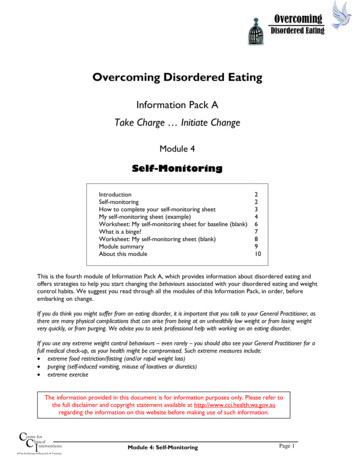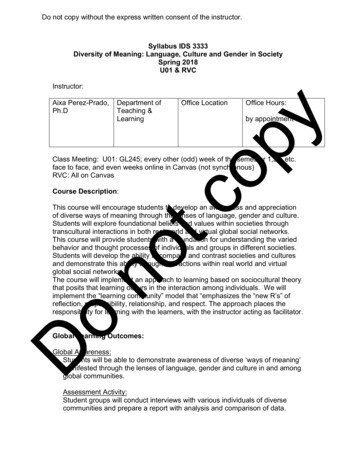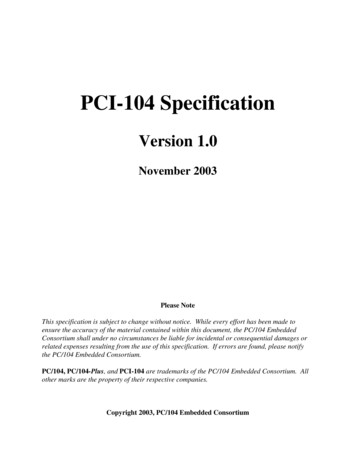
Transcription
OvercomingDisordered EatingOvercoming Disordered EatingInformation Pack ATake Charge Initiate ChangeModule 4Self-MonitoringIntroductionSelf-monitoringHow to complete your self-monitoring sheetMy self-monitoring sheet (example)Worksheet: My self-monitoring sheet for baseline (blank)What is a binge?Worksheet: My self-monitoring sheet (blank)Module summaryAbout this module2234678910This is the fourth module of Information Pack A, which provides information about disordered eating andoffers strategies to help you start changing the behaviours associated with your disordered eating and weightcontrol habits. We suggest you read through all the modules of this Information Pack, in order, beforeembarking on change.If you do think you might suffer from an eating disorder, it is important that you talk to your General Practitioner, asthere are many physical complications that can arise from being at an unhealthily low weight or from losing weightvery quickly, or from purging. We advise you to seek professional help with working on an eating disorder.If you use any extreme weight control behaviours – even rarely – you should also see your General Practitioner for afull medical check-up, as your health might be compromised. Such extreme measures include: extreme food restriction/fasting (and/or rapid weight loss) purging (self-induced vomiting, misuse of laxatives or diuretics) extreme exerciseThe information provided in this document is for information purposes only. Please refer tothe full disclaimer and copyright statement available at http://www.cci.health.wa.gov.auregarding the information on this website before making use of such information.forCentrelinicalC Interventions Psychotherapy Research TrainingModule 4: Self-MonitoringPage 1
OvercomingDisordered EatingIntroductionIn this module, we will begin to help you move into ‘Action’ mode. You will learn how to break the viciouscycle of your disordered eating by initiating a positive eating behaviour, self-monitoring. Self-monitoring willbecome an important part of improving your eating habits. This behaviour was mentioned in Module 1, butwill now be explored in greater detail.Self-MonitoringWhat is Self-Monitoring?Self-monitoring involves recording your daily food intake, and any eating disordered behaviours, plus anythoughts/feelings you were having at the time. You do this by completing daily self-monitoring sheets. Thismight be a scary prospect. We will therefore explain why this is important and then, hopefully, you willunderstand the benefits of self-monitoring.Why is Self-Monitoring Important?You may be asking yourself: “Why in the world would I want to write down all the awful food I eat, andthen what I do with it, then think about how I’m feeling, and then look at it?” It may seem like ahuge task, but it is extremely useful in overcoming disordered eating. Completing daily records ofyour eating behaviours provides you with information about your problem. You can become akind of detective, searching for clues: What triggered the disordered eating? What did I eat? Whatdid I do then? What was I thinking and feeling at the time? What conclusions can I draw?Research has shown that people who begin using self-monitoring sheets early in the change process havethe most positive outcomes. This is because the self-monitoring sheets allow people to have the mostaccurate picture of how the disordered eating keeps itself going and how it can be changed. It is importantthat you make an honest and accurate record. This may feel uncomfortable, but you will come to find this auseful tool for overcoming your disordered eating.Self-monitoring encourages you to analyse the thoughts that influence your eating and helps you to identifyinfluential thought patterns. For example, thinking negatively about yourself and your self-worth may lead toovereating. By recording your thoughts you become conscious of this pattern and can begin to counteractthese thoughts. Self-monitoring also helps you to identify situations that lead to disordered eating. Forexample, you may be in the habit of skipping meals all day, getting home in the afternoon feeling extremelyhungry, and then binge eating. By recording this behaviour, it becomes easier to become aware of theharmful patterns that maintain your disordered eating.Once you become aware of what is going on, you will find it easier to change, because you will know whatneeds changing! Also, once you become aware of your behaviours and begin to see patterns, you will startrealising that these behaviours are not just arbitrary and automatic, but CAN be changed. You will find thatself-monitoring becomes an important part of correcting your disordered eating. Initially, you may find thatrecording your food intake makes you feel uncomfortable. Most people who feel this way become morecomfortable with the process over time and find self-monitoring a useful tool for improving their eating.You may also fear that writing everything down will make you obsess MORE about food, and this may bethe case – but only in the short term. For long-term change it is very helpful.forCentrelinicalC Interventions Psychotherapy Research TrainingModule 4: Self-MonitoringPage 2
OvercomingDisordered EatingHow to complete your self-monitoring sheetAs part of making changes to your eating, you will need to complete a self-monitoring sheet that detailsyour food intake each day. The self-monitoring sheet records the time you ate, what you ate, where youate, if you considered the event to be a binge, if you engaged in vomiting or laxative use, and the situationand feelings that accompanied your eating. Overleaf you will find an example of a completed self-monitoringsheet, and it might help you to look at it in order to get an idea of what a completed self-monitoring sheetlooks like.There are some important issues to consider when you start self-monitoring: Be accurate and honest with yourself. You may feel tempted to omit food items or behavioursout of feelings of shame or guilt. However, not being completely truthful will only limit your progress.Remember that this is your record, and being honest with yourself is an important step in changingyour behaviour. Complete your self-monitoring sheets in “real-time”. Do not wait until the end of the day totry to remember what you ate. Recording your food intake while you eat (or immediately afterwards)will help you get a more accurate record of your thoughts and feelings, and the content of your meal. Itwill also help you analyse your thoughts and the situations that encourage you to eat. Do not record calories. Carry your self-monitoring sheets with you wherever you go, to assist you in making records.However we realise that it can be difficult to carry your self-monitoring sheets all the time. Somepeople find it helpful to carry a mini-notebook or jot down notes in their diary then transcribe theseinto their self-monitoring records later that day.The point of self-monitoring is not to add up your food intake at the end of the day. Self-monitoring willhelp you understand why you eat, and the processes and thoughts that lead to your disordered eating.Your self-monitoring sheets are important and it is crucial that you complete them honestly and accurately.Below are some guidelines for completing your self-monitoring sheet: Day and Date: note the day and date (one self-monitoring sheet per day) Time: Record the time you began the meal or snack. Food & liquid intake: Record both food and liquid intake, including water, soft drinks, coffee or tea,or alcohol. Bracket foods together when you consider them to be part of the same meal/snack. Location: Be specific about the location of your eating. If you are at home eating on the couch, write‘couch at home’ rather than ‘home’. This extra information may give you more insight into your eatinghabits. Binge: If you considered the meal or snack to be part of a binge episode, record an asterisk (*) in thiscolumn of your self-monitoring sheet. (See Page 7 for examples of what constitutes a binge.) Vomiting or laxative use: If you vomit, record a ‘V’ in this column. If laxatives are used, record an‘L’ in this column and write down how many you took. If the vomiting or use of laxatives do not occurin conjunction with food intake, record the event leaving the food intake column empty. Situation/feelings/thoughts: We ask you to record the situation, thoughts or feelings associatedwith your eating. Behaviours such as weighing and shape checking should also be recorded. This willgive you the chance to consider what triggered your eating, how you felt about your eating, and howyour eating made you feel about yourself. Exercise: If you exercise, record the time period you exercised and the type of exercise you engagein, as well as any thoughts or feelings associated with the exercise.forCentrelinicalC Interventions Psychotherapy Research TrainingModule 4: Self-MonitoringPage 3
OvercomingDisordered EatingBelow is an example of a completed record:My Self-monitoring SheetDayMondayTime7:30amDate 22/01/07Food & liquid intakeLocation2 pieces of toast withmargarine1 mug of am: Weighed myself. 65kgsLess than last night. Pleased.Kitchentable10:00 am1 can of diet PepsiAt work12:00 pmMug of coffeeAt work1:30 pmMug of coffeeAt workCake in the staffroom forcolleague’s birthday. Pleased Ididn’t eat any.Only coffee for lunch, trying tomake up for breakfast4:30pm4:40pm4:45pm4:53pm200gm packet of chips1 doughnut1 doughnut1 can of diet lemonade6 chocolate biscuits1L of ice cream1 can of diet lemonade2 pieces of toast,margarine and jamHome, infront of theTVSat in front of TV when I gothome. Felt bored, tired andhungry. Started eating.4:59pm5:15pm5:35pm]]]]]]]*****]*7:30pmMug of tea8:40pm1 piece of toast, vegemite ]1 large glass wine]5 pieces of toast,margarine & vegemite]1 cold apple pie]1 packet of chocolate chipcookies]8:44pm8:54pm9:00pmV5:45pm: Weighed myself.66.7kgs. Disgusted with myself.Vomited.Depressed about binge.Resolved not to eat for the restof the night.Mum called and said shewanted to go clothes shoppingtogether on the weekend. Feltanxious. Started to eat. Toodepressed to stop.****VFelt awful, couldn’t look in themirror. Vomited.Exercise (time and type): None. I’m just lazy idiotforCentrelinicalC Interventions Psychotherapy Research TrainingModule 4: Self-MonitoringPage 4
OvercomingDisordered EatingPreparing Yourself to Start Your Self-monitoring sheetsNow that you understand the benefits of self-monitoring and how to complete self-monitoring sheets, it isimportant to start recording! But before you begin recording your eating behaviours, let’s take a look athow you’re going to manage to complete those records.Take a moment to consider how you will fit self-monitoring into your own lifestyle. For example, if you willbe eating with friends or family, what will you do? Devise a plan that makes self-monitoring work for you.Please write your thoughts below.You will need to make a food intake record for each day. Initially, your self-monitoring will be used to makea record of your current eating pattern. During this period you should continue eating as you have been upuntil now. This will help you understand your current eating habits, and provide you with a baseline record.This is a record of what you’re currently eating, and then you will be able to identify changes in your eatingpatterns as you work through the modules in this information package.Your Baseline RecordsA baseline record means that we would like you to record your current food intake without making anychanges to how much you eat or binge. Start by completing the blank self-monitoring sheet overleaf onPage 6. Start now, whatever time of day it is. Write down everything you eat for the rest of today, andnote any disordered eating behaviours, plus any thoughts/feelings you might have at the time. (Go back toPage 3 for instructions and Page 4 for an example of a completed self-monitoring sheet.)A blank self-monitoring sheet is included at the end of this module (Page 8) to help you make your ownself-monitoring records. Print out or copy 4 more blank self-monitoring sheets. Starting from NOW,complete a self-monitoring sheet every day. Make a record of what you eat, when and where you eat it, ifyou consider it a binge, if you used vomiting or laxatives, and what was going on at the time, as well as yourthoughts and feelings.At the end of 4 days, make some time to look over your self-monitoring sheets. Even if you go ahead nowand finish reading this module – and perhaps more modules – make sure you complete your daily selfmonitoring sheets and also that you look over them after a few days.Reviewing Your Baseline RecordsOnce you have 4 or 5 days worth of self-monitoring forms, set aside about half an hour to review them.What do you see? Can you identify any trends or patterns to your eating and related behaviours? Do youtend to binge on certain types of foods? Do you binge at a certain time of day? After the same events?Accompanied by the same emotions? Write down some observations.By the end of 4-5 days you will be ready to move on to regular eating and more self-monitoring.Overleaf you will find a blank self-monitoring sheet to start completing NOW.forCentrelinicalC Interventions Psychotherapy Research TrainingModule 4: Self-MonitoringPage 5
OvercomingDisordered EatingMy Self-monitoring sheetDayTimeFood & liquid elingsExercise (time and type):forCentrelinicalC Interventions Psychotherapy Research TrainingModule 4: Self-MonitoringPage 6
OvercomingDisordered EatingDefinition of a BingeSometime it can be hard to determine if you have binged. Remember, to count as a binge,1) The amount of food has to be: larger than others would eat in similar circumstances eaten within a 2-hour period2) You have to feel out of control while eating, as if you couldn’t stop even if you wanted to, or youcouldn’t resist starting.Here are some examples of LARGE:cake – 4 regular slicescereal – 6 cupschips (packet – potato or corn) – 250 g/8 ozchips (French fries) – 3 large servingschocolate – 3 bars if dense, 4 if regular, 8 fun-sizecorn on the cob - 4 piecescroissants or Danish pastries or doughnuts – 4eggs – 5 (6 if scrambled or omelette)toast – 6 slicesfruit – 5 pieceshamburgers with bun - 3hot dogs with bun – 4ice cream – 6 scoopsnuts – 2.5 cupspasta (cooked) – 6 cupspeanut butter – 6 tablespoonspizza (large size) – 6 slicespopcorn – 3 microwave bagssteak – 500g/16 ozOverleaf you will find another blank self-monitoring sheet that you can copy or print out.Good luck with your food monitoring!forCentrelinicalC Interventions Psychotherapy Research TrainingModule 4: Self-MonitoringPage 7
OvercomingDisordered EatingMy Self-monitoring sheetDayTimeFood & liquid elingsExercise (time and type):forCentrelinicalC Interventions Psychotherapy Research TrainingModule 4: Self-MonitoringPage 8
OvercomingDisordered EatingModule Summary Self-monitoring is an eating behaviour that you will need to start immediately.Self-monitoring involves recording your food intake each day. You will need to record the time ofeating, what you ate, the location of eating, the presence of binge eating, vomiting or laxatives use, anyexercise and the situation/thoughts/feelings surrounding your eating.Self-monitoring sheets should be recorded in “real time”.Self-monitoring will help you to analyse your eating habits and behaviours. It will also allow you toidentify thought patterns or events that lead to disordered eating.What I Have Learned in this ModuleThink about what you have learned in this module and any useful bits of information, tips or strategies thatyou want to remember. Write them down below so you can refer to them later.Think about how you might use the information you have just learned. Write down some ways in whichyou could make use of this information.Coming Up In Module 5 (Regular Eating & Regular Weighing) youwill continue to work in ‘Action’ mode, learning how toaddress your disordered eating by initiating regulareating and regular weighing.forCentrelinicalC Interventions Psychotherapy Research TrainingModule 4: Self-MonitoringPage 9
OvercomingDisordered EatingAbout This ModuleCONTRIBUTORSDr. Anthea Fursland (Ph.D.1)Principal Clinical PsychologistCentre for Clinical InterventionsPaula Nathan (M.Psych.3)Director, Centre for Clinical InterventionsAdjunct Senior Lecturer, School of Psychiatry andClinical Neuroscience, University of Western AustraliaDr. Sue Byrne (Ph.D.1, D.Phil.2)Senior Clinical PsychologistUniversity of Western Australia andCentre for Clinical InterventionsAmy Lampard (B.A. Hons4)MPsych (Clinical)/ PhD CandidateUniversity of Western AustraliaDoctor of Philosophy (Clinical Psychology)3 Master of Psychology (Clinical Psychology)2 Doctor14of Philosophy (Clinical Psychology)Bachelor of Arts (Psychology) with HonoursWe would also like to thank Karina Allen for her contributions to the presentation of these Information Packs.BACKGROUND AND REFERENCESThe concepts and strategies in this module have been developed from evidence-based psychologicaltreatment of eating disorders, primarily Cognitive Behaviour Therapy (CBT). This can be found in thefollowing: Fairburn, C. G. (1995) Overcoming Binge Eating. New York: The Guilford PressFairburn, C. G., Cooper, Z., & Shafran, R. (2003) Cognitive behaviour therapy for eating disorders:a “transdiagnostic” theory and treatment. Behaviour Research and Therapy 41, pp 509-528Fairburn, C. G. (2008) Cognitive Behavior Therapy and Eating Disorders. New York: The GuilfordPress“OVERCOMING DISORDERED EATING”This module forms part of:Fursland, A., Byrne, S. & Nathan, P. (2007) Overcoming Disordered Eating. Perth, Western Australia: Centrefor Clinical InterventionsISBN: 0-975799525forCentrelinicalC Interventions Psychotherapy Research TrainingCreated: March 2007. Revised November 2010.Module 4: Self-MonitoringPage 10
The point of self-monitoring is not to add up your food intake at the end of the day. Self-monitoring will help you understand why you eat, and the processes and thoughts that lead to your disordered eating. Your self-monitoring sheets are important and it i










